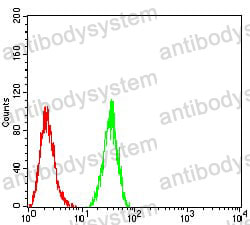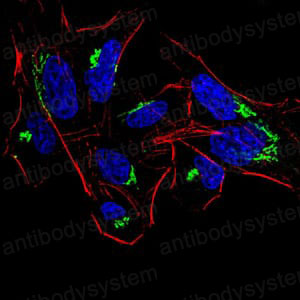Catalog No.
RHF17201
Species reactivity
Human
Host species
Mouse
Isotype
IgG1
Clonality
Monoclonal
Tested applications
ELISA: 1:10000, FCM: 1:200-1:400, IF: 1:200-1:1000
Target
Histone deacetylase 4, HDAC4, HD4, KIAA0288
Concentration
1 mg/ml
Endotoxin level
Please contact with the lab for this information.
Purity
>95% as determined by SDS-PAGE.
Purification
Protein A/G purified from cell culture supernatant.
Accession
P56524
Applications
ELISA, FCM, IF
Form
Liquid
Storage buffer
0.01M PBS, pH 7.4, 0.05% Sodium Azide.
Stability and Storage
Use a manual defrost freezer and avoid repeated freeze-thaw cycles. Store at 4°C short term (1-2 weeks). Store at -20°C 12 months. Store at -80°C long term.
Clone ID
R3N56
Brief research report: WGCNA-driven identification of histone modification genes as potential biomarkers in AQP4-Associated optic neuritis., PMID:39238786
Functional analysis of protein interactions using coupled bi-fluorescence complementation/GFP nanobody techniques., PMID:38932691
Combinatorial immune checkpoint blockade increases myocardial expression of NLRP-3 and secretion of H-FABP, NT-Pro-BNP, interleukin-1β and interleukin-6: biochemical implications in cardio-immuno-oncology., PMID:38322766
Calotropis procera: A double edged sword against glioblastoma, inhibiting glioblastoma cell line growth by targeting histone deacetylases (HDAC) and angiogenesis., PMID:38304784
Blocking insulin-like growth factor 1 receptor signaling pathway inhibits neuromuscular junction regeneration after botulinum toxin-A treatment., PMID:37717026
HDAC4 depletion ameliorates IL-13-triggered inflammatory response and mucus production in nasal epithelial cells via activation of SIRT1/NF-κB signaling., PMID:36301023
Epigenetic Modifications in Placenta are Associated with the Child's Sensitization to Allergens., PMID:31111043
Axotomy-Induced Changes of the Protein Profile in the Crayfish Ventral Cord Ganglia., PMID:31066008
Insulin induces Thr484 phosphorylation and stabilization of SIK2 in adipocytes., PMID:30586628
Nucleus accumbens-associated protein-1 promotes glycolysis and survival of hypoxic tumor cells via the HDAC4-HIF-1α axis., PMID:28319066
Assessing angiogenic responses induced by primary human prostate stromal cells in a three-dimensional fibrin matrix assay., PMID:27542256
Molecular and Functional Characterization of Histone Deacetylase 4 (HDAC4)., PMID:27246207
Elevated local [Ca2+] and CaMKII promote spontaneous Ca2+ release in ankyrin-B-deficient hearts., PMID:27131508
Histone deacetylase 4 increases progressive epithelial ovarian cancer cells via repression of p21 on fibrillar collagen matrices., PMID:26572940
The MEF2-HDAC axis controls proliferation of mammary epithelial cells and acini formation in vitro., PMID:26403201
Histone Deacetylase 3 and 4 Complex Stimulates the Transcriptional Activity of the Mineralocorticoid Receptor., PMID:26305553
A central role for TRPS1 in the control of cell cycle and cancer development., PMID:25277197
Targets for future clinical trials in Huntington's disease: what's in the pipeline?, PMID:25155142
Expression of histone deacetylases in diffuse large B-cell lymphoma and its clinical significance., PMID:25076845
Valproic acid prevents penile fibrosis and erectile dysfunction in cavernous nerve-injured rats., PMID:24636283
Anticancer effects of sodium butyrate on hepatocellular carcinoma cells in vitro., PMID:23440283
Tocilizumab attenuates inflammation in ALS patients through inhibition of IL6 receptor signaling., PMID:23383400
Modulation of inositol 1,4,5-trisphosphate receptor type 2 channel activity by Ca2+/calmodulin-dependent protein kinase II (CaMKII)-mediated phosphorylation., PMID:23019322
450K-array analysis of chronic lymphocytic leukemia cells reveals global DNA methylation to be relatively stable over time and similar in resting and proliferative compartments., PMID:22922567
Selective repression of MEF2 activity by PKA-dependent proteolysis of HDAC4., PMID:22042619
HDAC inhibition promotes cardiogenesis and the survival of embryonic stem cells through proteasome-dependent pathway., PMID:21751234
Peroxisome proliferator-activated receptor γ is inhibited by histone deacetylase 4 in cortical neurons under oxidative stress., PMID:21605119
microRNA-dependent modulation of histone acetylation in Waldenstrom macroglobulinemia., PMID:20519629
[Prokaryotic expression and purification of N-terminal and C-terminal fragments of histone deacetylase 4]., PMID:20423832
[Effects of Epstein-Barr virus on host gene expression in Burkitt's lymphoma cell lines]., PMID:19664326
High histone deacetylase 7 (HDAC7) expression is significantly associated with adenocarcinomas of the pancreas., PMID:18506539
HDAC4 and PCAF bind to cardiac sarcomeres and play a role in regulating myofilament contractile activity., PMID:18250163
Tumor necrosis factor-alpha enhances neutrophil adhesiveness: induction of vascular cell adhesion molecule-1 via activation of Akt and CaM kinase II and modifications of histone acetyltransferase and histone deacetylase 4 in human tracheal smooth muscle cells., PMID:18227124
Impaired placental trophoblast lineage differentiation in Alkbh1(-/-) mice., PMID:18163532
Sumoylation of the zinc finger protein ZXDC enhances the function of its transcriptional activation domain., PMID:17696781
HDAC2 controls IgM H- and L-chain gene expressions via EBF1, Pax5, Ikaros, Aiolos and E2A gene expressions., PMID:17352740
HDAC activity regulates entry of mesoderm cells into the cardiac muscle lineage., PMID:17038545
Histone deacetylase (HDAC) 4 involvement in both Lewy and Marinesco bodies., PMID:16972890
Involvement of HDAC1 and the PI3K/PKC signaling pathways in NF-kappaB activation by the HDAC inhibitor apicidin., PMID:16870149
Nuclear accumulation of histone deacetylase 4 (HDAC4) coincides with the loss of androgen sensitivity in hormone refractory cancer of the prostate., PMID:15036687
14-3-3tau associates with and activates the MEF2D transcription factor during muscle cell differentiation., PMID:11433030
SMRTE inhibits MEF2C transcriptional activation by targeting HDAC4 and 5 to nuclear domains., PMID:11304536


